To set up a starter emergency fund, first review your finances by tracking income and expenses to identify where you can save. Then, determine a realistic goal—covering 2-3 months of essential expenses. Open a dedicated savings account, ideally with low fees and interest. Automate regular transfers to build your fund steadily and explore extra income sources. Keep monitoring your progress to stay motivated, and if you continue exploring, you’ll discover more tips to strengthen your cushion.
Key Takeaways
- Evaluate your current financial situation to determine how much you can save regularly.
- Set a realistic emergency fund goal covering 2-3 months of essential expenses.
- Open a dedicated, low-fee savings account with easy access for quick emergencies.
- Automate monthly transfers to build your emergency fund consistently.
- Track your progress regularly to stay motivated and adjust savings as needed.
Assessing Your Financial Situation
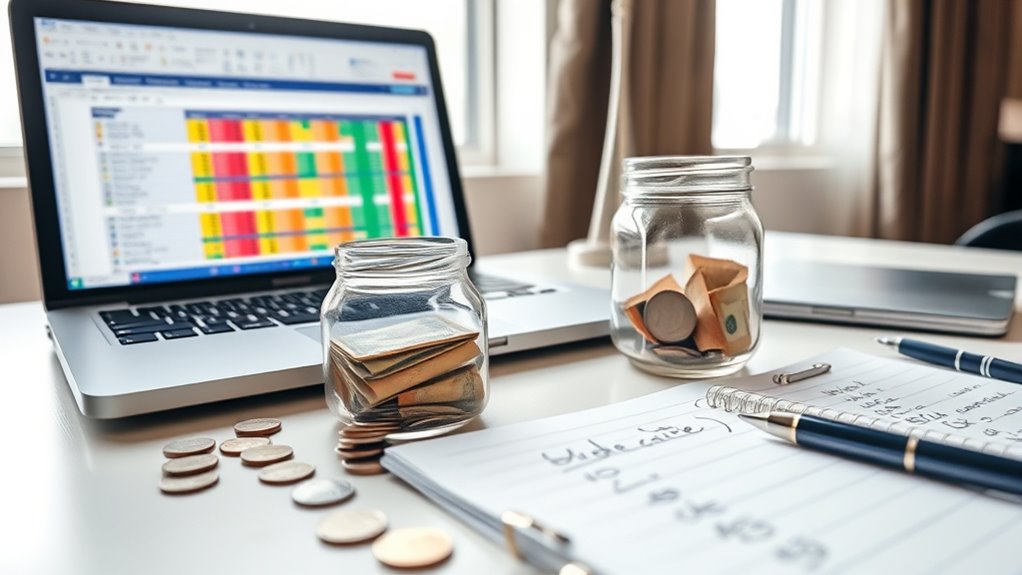
Have you ever wondered where your money is going each month? The first step in building an emergency fund is evaluating your financial situation. Start by tracking your income and expenses for a month. List all sources of income, then write down every expense, from rent to small daily purchases. This will help you identify where your money is going and highlight areas to cut back. Be honest with yourself—acknowledging unnecessary expenses is vital. Review your bank statements and receipts to verify accuracy. Once you have a clear picture of your cash flow, you can decide how much money you can realistically set aside each month. Knowing your financial landscape is fundamental before moving forward with your emergency fund plan. Additionally, understanding how emerging machine learning tools can analyze your spending patterns may provide insights to optimize your savings strategies. Leveraging such AI-driven solutions can further enhance your ability to manage and grow your emergency fund effectively. Incorporating personal finance management techniques can also help you stay committed to your savings goals.
Setting a Realistic Savings Goal
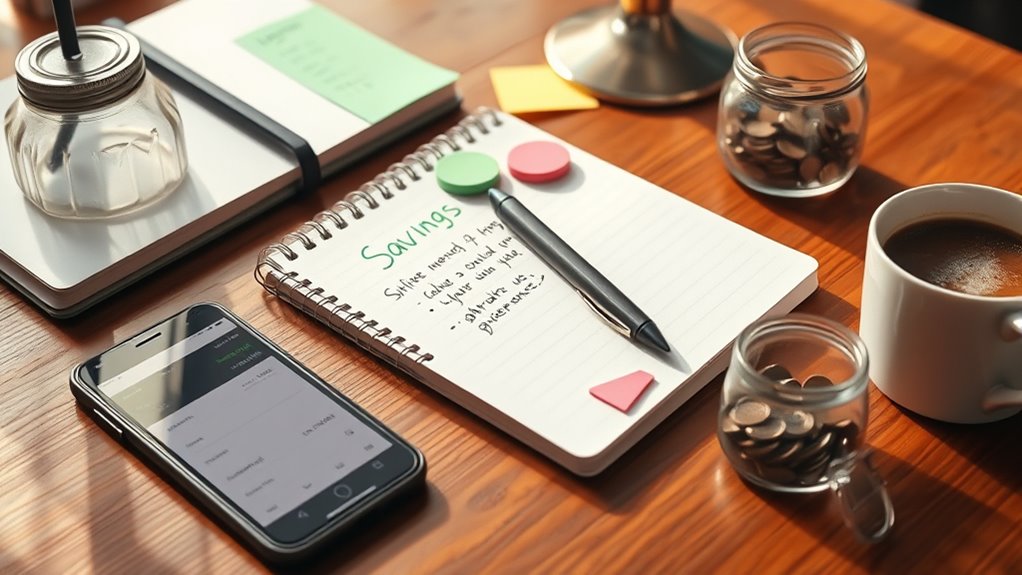
Setting a realistic savings goal is essential to building an effective emergency fund. You need to determine how much money will cover your basic needs during unexpected events, like job loss or medical emergencies. Start by calculating your essential monthly expenses—rent, groceries, utilities, transportation, and insurance. Multiply this amount by two or three months to get a target goal. Be practical about your income and expenses; setting an unattainable goal can discourage you. Break your goal into manageable monthly savings targets, making it easier to stay motivated. Remember, even a small, consistent contribution adds up over time. Incorporating space and organization strategies can help you free up funds and stay committed to your savings plan. Additionally, understanding bedroom organization tips can help you identify areas to cut costs and optimize your savings efforts. Regularly reviewing your financial organization can ensure your savings plan adapts to your changing circumstances. Adjust your goal as your financial situation changes, ensuring it remains achievable and relevant to your needs. Being aware of home theater technology options can also inspire cost-effective ways to enhance your living space while sticking to your savings objectives. Moreover, recognizing the importance of self-awareness can help you stay disciplined and motivated in your financial journey.
Opening a Dedicated Savings Account

Opening a dedicated savings account is a crucial step in building your emergency fund. It keeps your savings separate from your everyday spending account, reducing the temptation to dip into those funds. Choose an account with no or low fees and easy access when needed. Look for options that offer interest to help your savings grow over time. Consider online banks or credit unions, which often provide better rates and fewer charges. Make sure the account allows you to transfer money quickly when an emergency arises. Setting up automatic transfers from your main account ensures consistent contributions without extra effort. Additionally, understanding privacy and cookie usage can be beneficial, as safeguarding your financial information is vital during online banking activities. Being aware of affiliate disclosures helps you understand how your data may be used when shopping online, reinforcing the importance of privacy measures. Researching secure banking practices can further protect your funds from unauthorized access. Implementing financial literacy resources can further empower you to manage your emergency fund effectively. This dedicated account becomes your financial safety net, giving you peace of mind and making it easier to reach your emergency fund goal.
Creating a Budget to Free Up Funds
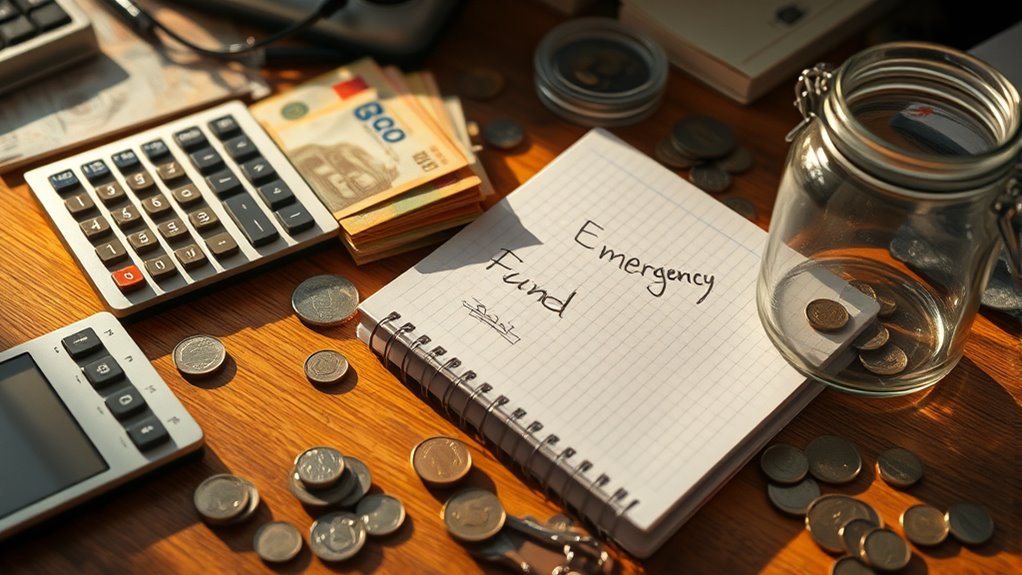
To create a budget that frees up funds, you need to understand your spending habits. Track your expenses to see where your money goes each month, and look for areas to cut back. By identifying these cost-cutting opportunities, you can redirect more money toward your emergency fund. Incorporating mindful spending practices, such as prioritizing essential expenses, can further enhance your savings efforts. Leveraging data-driven strategies can also help you make informed decisions about your finances and optimize your savings plan. Additionally, being aware of security vulnerabilities in new payment technologies and other daily indulgences can help you identify small savings that add up over time. Implementing techniques like the 50/30/20 rule can streamline your budget allocation and improve your financial discipline.
Track Spending Patterns
Understanding your spending habits is the first step toward building a solid emergency fund. By tracking how much you spend and where your money goes, you gain clarity on your financial flow. Use a journal, app, or spreadsheet to record every expense, from big bills to small purchases. Review your spending patterns weekly to identify trends and habits, such as unnecessary subscriptions or impulse buys. This awareness helps you see where your money leaks and which expenses are essential. As you monitor, you’ll start noticing areas where you can cut back, making it easier to allocate funds toward your emergency savings. Incorporating HEPA filtration can also help you analyze your spending data more effectively. Regularly reviewing your expenses with industry trend awareness ensures you stay aligned with your financial goals and adapt your budget as needed.
Identify Cost-Cutting Areas
Creating a budget is essential for identifying areas where you can cut costs and free up funds for your emergency savings. Start by reviewing your spending patterns and noting expenses you can reduce or eliminate. Look at discretionary spending like dining out, entertainment, and subscriptions—these are often easy to trim. Evaluate fixed costs such as utilities, insurance, and memberships to see if there are cheaper options or ways to lower bills. Prioritize needs over wants, and set limits on unnecessary expenses. Small adjustments can add up quickly, boosting your savings faster. Keep track of your progress and stay committed to your budget. By cutting costs strategically, you free up more money to build your emergency fund efficiently.
Automating Your Savings

Automating your savings makes building an emergency fund much easier. Set up automatic transfers to move money into your fund regularly, and pick consistent dates so it becomes a habit. Keep track of your progress often to stay motivated and guarantee you’re on track.
Set Up Automatic Transfers
Setting up automatic transfers makes saving effortless by ensuring your money moves into your emergency fund without you having to think about it. You can link your checking account to your savings account or emergency fund account and schedule transfers on a regular basis. Choose a fixed amount that fits your budget and set the transfer to occur immediately after your paycheck arrives. This way, you prioritize saving before spending. Automating transfers removes the temptation to skip savings and helps you stay consistent. Most banks and financial apps let you customize these transfers easily. Once set up, you won’t have to remember to save each month. Over time, this simple step builds your emergency fund steadily and stress-free.
Choose Consistent Savings Dates
Once you’ve established automatic transfers, choosing consistent savings dates helps keep your emergency fund on track. Pick a specific day each month—like the 1st or the 15th—that aligns with your pay schedule or when bills are due. This consistency removes guesswork and helps you develop a habit of saving regularly. If your income varies, choose a date soon after you receive your paycheck so funds are automatically allocated before expenses pile up. Make sure the date works with your cash flow and isn’t too close to other financial commitments. Sticking to a set date minimizes the risk of forgetting or delaying savings, ensuring your emergency fund grows steadily and stays on course.
Track Progress Regularly
Tracking your progress regularly guarantees your emergency fund stays on track and helps you stay motivated. By reviewing your savings weekly or monthly, you can quickly spot any gaps and adjust your habits if needed. Automating your tracking through bank alerts or budgeting apps makes this process effortless. These tools can send notifications when you hit savings milestones or remind you to contribute if you’ve fallen behind. Seeing tangible progress reinforces your commitment and keeps you focused on your goal. It also allows you to celebrate small wins, boosting your confidence. Consistent monitoring ensures your emergency fund grows steadily, giving you peace of mind. Make tracking a routine, and you’ll stay motivated to reach your financial safety net faster.
Finding Extra Sources of Income
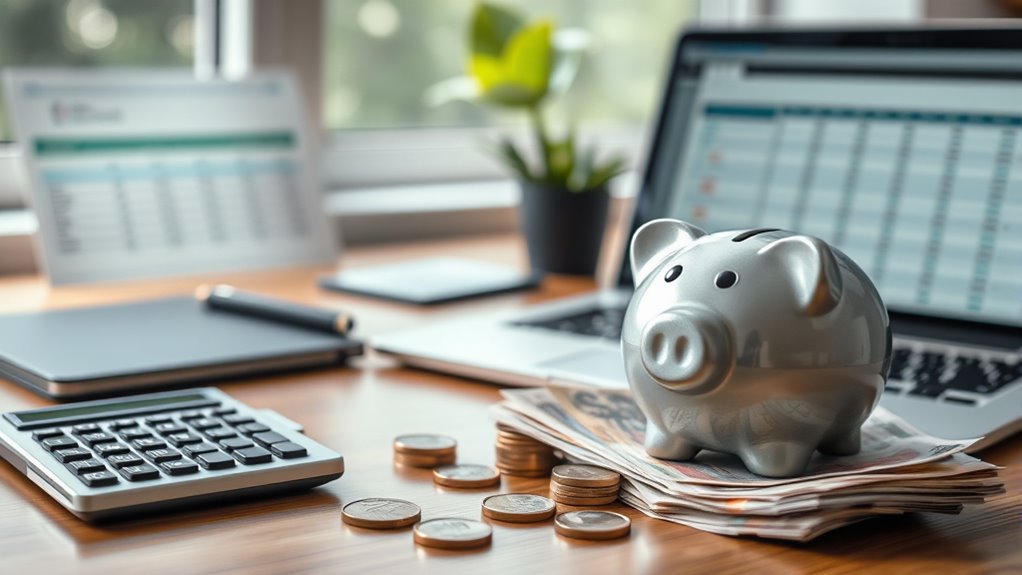
Looking for ways to boost your income can make a significant difference when building your emergency fund. Consider taking on side gigs like freelancing, tutoring, or delivering food. If you have a skill, offer it online through platforms like Upwork or Fiverr. Selling unused items around your home can also generate quick cash. Explore part-time jobs or seasonal work that fit your schedule. You might also monetize a hobby, such as photography or crafting, by selling your creations. Additionally, look into passive income options like investing in dividend-paying stocks or rental property, if feasible. Every extra rupee, dollar, or euro earned helps you reach your emergency fund goal faster, providing greater financial security and peace of mind.
Tracking Your Progress and Adjusting
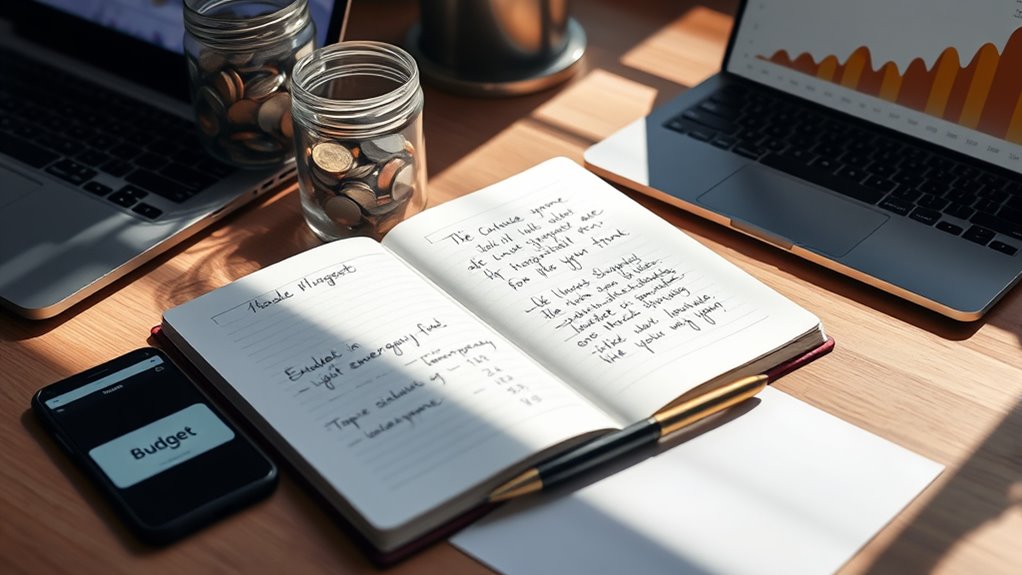
To stay on track with your emergency fund, regularly monitor your savings progress and compare it to your goals. This helps you identify if you’re ahead, on schedule, or falling behind. Adjust your plan as needed to stay motivated and realistic. Keep track of your contributions, expenses, and setbacks. Use these insights to refine your approach and set new milestones. Remember, progress isn’t always linear, and setbacks happen. Stay flexible and proactive.
- Review your savings weekly or monthly to spot trends.
- Celebrate small wins to stay motivated.
- Reassess your goals if your financial situation changes.
- Cut unnecessary expenses to boost contributions.
- Seek support or advice when facing obstacles.
Tracking and adjusting keeps your emergency fund journey focused and achievable.
Tips for Staying Consistent and Motivated
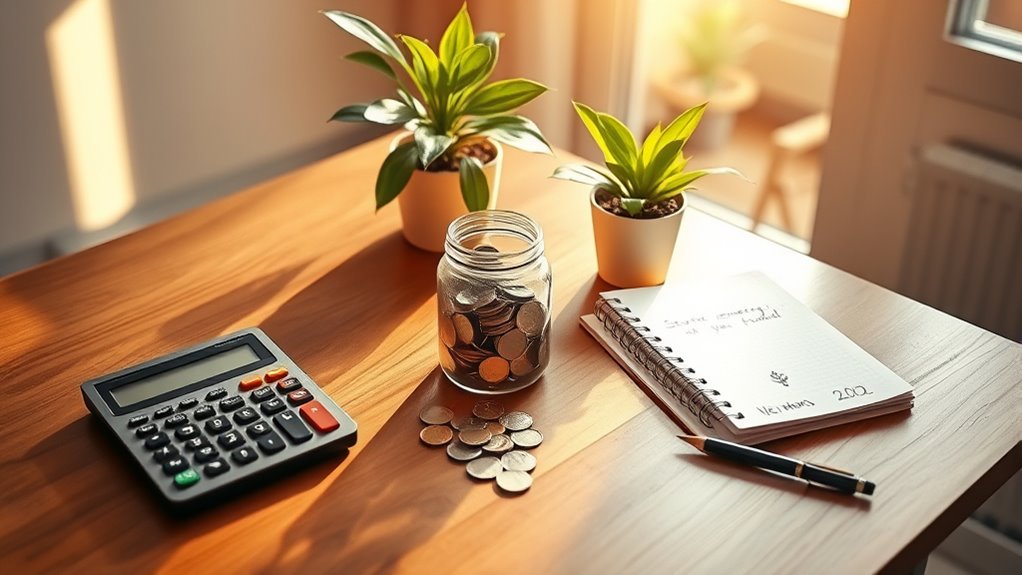
Staying consistent with your savings can be challenging, especially when progress feels slow or obstacles arise. To stay motivated, remind yourself of the reason you’re building this fund—whether it’s for peace of mind or unexpected expenses. Break your goal into smaller milestones, so each small victory keeps you encouraged. Automate your savings, so it happens automatically without thinking. Celebrate your progress, but avoid overspending when you hit a milestone. Keep your motivation high by visualizing how your emergency fund will protect you during tough times. Stay accountable by sharing your goal with a trusted friend or family member. Remember, consistency is key, and every small contribution brings you closer to financial security.
Frequently Asked Questions
How Much Should I Initially Save for My Emergency Fund?
You should aim to save enough to cover three to six months’ worth of essential expenses. Start small if needed, focusing on building gradually. Focus on your fixed costs like rent, groceries, and utilities. Keep your savings in a readily accessible account. Regularly review and adjust your fund as your financial situation changes. Remember, even a modest emergency fund provides peace of mind and financial security.
What if I Face Unexpected Expenses While Saving?
When facing unforeseen expenses while saving, stay calm and confront the crisis calmly. Cut costs, cancel non-essentials, and consider temporary side gigs to gather funds quickly. Prioritize urgent expenses and communicate with creditors if needed. Keep your goal in mind and stay consistent, even if setbacks occur. Remember, setbacks are part of the journey, so keep focused, be flexible, and your emergency fund will grow stronger with persistence.
Can I Use a Credit Card Temporarily for Emergencies?
Using a credit card temporarily for emergencies can be helpful, but you should do so cautiously. It’s a quick solution when you lack immediate cash, but remember, credit cards often come with high interest rates. Make sure to pay off the balance as soon as possible to avoid debt. Keep in mind, relying on credit cards isn’t a substitute for building a dedicated emergency fund, which provides more financial security.
How Often Should I Review and Update My Emergency Fund Goal?
You should review and update your emergency fund goal at least once a year or whenever your financial situation changes considerably, like a new job, salary increase, or major expenses. Regular reviews help guarantee your fund stays adequate for unexpected emergencies. By staying proactive, you can adjust your savings plan accordingly, maintaining financial security and peace of mind during unforeseen circumstances.
Is It Better to Save in Cash or Digital Accounts?
When deciding whether to save in cash or digital accounts, think about convenience and security. Cash is easy to access but vulnerable to theft or loss. Digital accounts, like savings apps or bank accounts, offer safety and easy transfers. You should use a combination: keep some cash for immediate needs and store the rest digitally for secure, quick access and better interest rates. This balance guarantees you’re prepared for emergencies efficiently.
Conclusion
Now that you’ve mapped your money’s movement and made a plan, stay steadfast and savvy. Keep your commitment clear, celebrate small wins, and let your savings grow steadily. With discipline and determination, your emergency fund will flourish like a forest in full bloom, offering safety and security. Remember, persistence paves the path to preparedness, turning tiny steps into a triumphant, thriving safety net you can rely on anytime trouble strikes.









